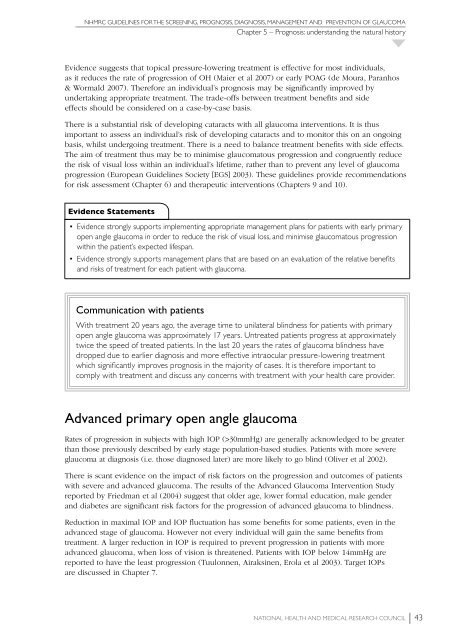NHMRC Glaucoma Guidelines - ANZGIG
NHMRC Glaucoma Guidelines - ANZGIG
NHMRC Glaucoma Guidelines - ANZGIG
Create successful ePaper yourself
Turn your PDF publications into a flip-book with our unique Google optimized e-Paper software.
<strong>NHMRC</strong> GUIDELINES FOR THE SCREENING, PROGNOSIS, DIAGNOSIS, MANAGEMENT AND PREVENTION OF GLAUCOMA<br />
Chapter 5 – Prognosis: understanding the natural history<br />
Evidence suggests that topical pressure-lowering treatment is effective for most individuals,<br />
as it reduces the rate of progression of OH (Maier et al 2007) or early POAG (de Moura, Paranhos<br />
& Wormald 2007). Therefore an individual’s prognosis may be significantly improved by<br />
undertaking appropriate treatment. The trade-offs between treatment benefits and side<br />
effects should be considered on a case-by-case basis.<br />
There is a substantial risk of developing cataracts with all glaucoma interventions. It is thus<br />
important to assess an individual’s risk of developing cataracts and to monitor this on an ongoing<br />
basis, whilst undergoing treatment. There is a need to balance treatment benefits with side effects.<br />
The aim of treatment thus may be to minimise glaucomatous progression and congruently reduce<br />
the risk of visual loss within an individual’s lifetime, rather than to prevent any level of glaucoma<br />
progression (European <strong>Guidelines</strong> Society [EGS] 2003). These guidelines provide recommendations<br />
for risk assessment (Chapter 6) and therapeutic interventions (Chapters 9 and 10).<br />
Evidence Statements<br />
• Evidence strongly supports implementing appropriate management plans for patients with early primary<br />
open angle glaucoma in order to reduce the risk of visual loss, and minimise glaucomatous progression<br />
within the patient’s expected lifespan.<br />
• Evidence strongly supports management plans that are based on an evaluation of the relative benefits<br />
and risks of treatment for each patient with glaucoma.<br />
Communication with patients<br />
With treatment 20 years ago, the average time to unilateral blindness for patients with primary<br />
open angle glaucoma was approximately 17 years. Untreated patients progress at approximately<br />
twice the speed of treated patients. In the last 20 years the rates of glaucoma blindness have<br />
dropped due to earlier diagnosis and more effective intraocular pressure-lowering treatment<br />
which significantly improves prognosis in the majority of cases. It is therefore important to<br />
comply with treatment and discuss any concerns with treatment with your health care provider.<br />
Advanced primary open angle glaucoma<br />
Rates of progression in subjects with high IOP (>30mmHg) are generally acknowledged to be greater<br />
than those previously described by early stage population-based studies. Patients with more severe<br />
glaucoma at diagnosis (i.e. those diagnosed later) are more likely to go blind (Oliver et al 2002).<br />
There is scant evidence on the impact of risk factors on the progression and outcomes of patients<br />
with severe and advanced glaucoma. The results of the Advanced <strong>Glaucoma</strong> Intervention Study<br />
reported by Friedman et al (2004) suggest that older age, lower formal education, male gender<br />
and diabetes are significant risk factors for the progression of advanced glaucoma to blindness.<br />
Reduction in maximal IOP and IOP fluctuation has some benefits for some patients, even in the<br />
advanced stage of glaucoma. However not every individual will gain the same benefits from<br />
treatment. A larger reduction in IOP is required to prevent progression in patients with more<br />
advanced glaucoma, when loss of vision is threatened. Patients with IOP below 14mmHg are<br />
reported to have the least progression (Tuulonnen, Airaksinen, Erola et al 2003). Target IOPs<br />
are discussed in Chapter 7.<br />
National Health and Medical Research Council 43





